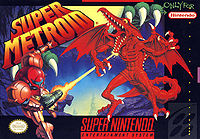From NintendoWiki, your source on Nintendo information. By fans, for fans.
|
|
| Line 29: |
Line 29: |
| | |textlight= yes | | |textlight= yes |
| | }} | | }} |
| − | '''''Super Metroid'''' is the third game in the {{ser|Metroid}} franchise, released for the [[Super Nintendo Entertainment System|SNES]] in 1994. Referred to as "Metroid 3" in-game, it is a direct sequel to ''[[Metroid II: Return of Samus]]'', and eight years later would receive a sequel in the form of ''[[Metroid Fusion]]''. Even later, in 2010, ''[[Metroid: Other M]]'' would be released as a direct follow-up to this game. | + | '''''Super Metroid''''' is the third game in the {{ser|Metroid}} franchise, released for the [[Super Nintendo Entertainment System|SNES]] in 1994. Referred to as "Metroid 3" in-game, it is a direct sequel to ''[[Metroid II: Return of Samus]]'', and eight years later would receive a sequel in the form of ''[[Metroid Fusion]]''. Even later, in 2010, ''[[Metroid: Other M]]'' would be released as a direct follow-up to this game. |
| | | | |
| | ==Blurb== | | ==Blurb== |
Revision as of 18:18, 26 September 2015
| Super Metroid
|
| スーパーメトロイド
|

Boxart for Super Metroid
|
|
|
|
| N. America:
|
April 18, 1994
|
| Japan:
|
March 19, 1994
|
| Europe:
|
July 28, 1994
|
| Australia:
|
N/A
|
| S. Korea:
|
N/A
|
|
|
|
|
|
Super Metroid is the third game in the Metroid franchise, released for the SNES in 1994. Referred to as "Metroid 3" in-game, it is a direct sequel to Metroid II: Return of Samus, and eight years later would receive a sequel in the form of Metroid Fusion. Even later, in 2010, Metroid: Other M would be released as a direct follow-up to this game.
Blurb

|
This section is a stub. You can help NintendoWiki by expanding it.
|
Story
The story of Super Metroid is set near-directly after the events of Metroid II. After Samus brought about the near-extinction of the Metroids and rescued the Metroid hatchling on SR388, she gave it to the Ceres Space Colony for research. Soon after, she receives a distress signal and returns to the space station to investigate, finding the researchers dead. She then finds the Metroid, but Ridley appears and captures it, activating the station's self-destruct sequence. After Samus escapes, she chases Ridley to Zebes, where she must fight and defeat the Space Pirates once again to save the baby Metroid.
Gameplay
Gameplay largely remains the same as in Metroid and Metroid II, but has seen some changes. Like in the original, the game is set on Zebes, an open-ended world that players, controlling Samus Aran, are able to explore. Players travel around the world collecting upgrades such as new weapons and equipment to navigate the world further, the main goal being to defeat four bosses scattered around the planet in order to access the Space Pirates' new base. While Samus retains many of her moves and much of the equipment is the same, Super Metroid introduces many new techniques and abilities that would become staples of the series in later installments.
Samus has a health bar that can be upgraded, and when it depletes to zero the player is given a game over. This game carries over the saving function seen in Metroid II and the Famicom Disk System version of the original, allowing players to save their progress at specified points, including Samus' ship. The game also has an inventory screen, which allows players to view a map of the area they are in and enable and disable their equipment at will.
Super Metroid also has a time-based ending sequence, determined by how long it takes for the player to complete the game.
Technical details
External links
References

